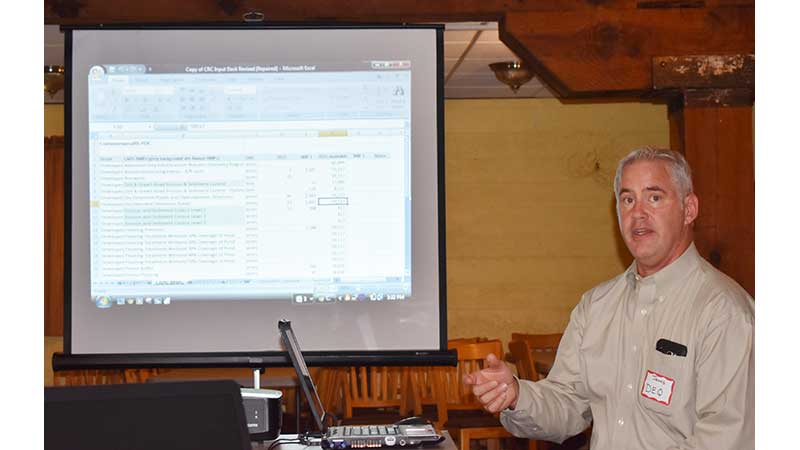CRC discuss watershed action
Published 5:50 am Wednesday, September 5, 2018
Members of the Commonwealth Regional Council (CRC), area planning and zoning directors and state officials learned about ways their counties can take part in keeping their area waterways free from pollutants during a meeting held at The Mill Room in Farmville on Thursday.
Those in attendance included CRC Executive Director Melody Foster; Virginia Department of Environmental Quality (VDEQ) Chesapeake Bay Coordinator James Davis-Martin; Ed Dunn, environmental health manager with Piedmont Health District; Kirby Woolfork with Virginia Department of Forestry; Buckingham County Zoning and Planning Administrator Rebecca Cobb; Cumberland County Planning and Zoning Director J.P. Duncan and Ashley Hall and Kendall Effler with Stantec, an engineering and design company working with Virginia Department of Transportation to provide stormwater infrastructure to protect roadways.
The watershed implementation plan is a non-binding item, meaning that the state cannot enforce localities to participate. Foster said the plan acts more like a wish list to justify funding needs to the Virginia General Assembly.
The council previously discussed participating in the watershed program after being contacted by VDEQ and hosting a previous meeting about the program earlier in the summer.
Cam Johnson, regional planner for CRC, gave an overview of the Virginia Department of Environmental Quality’s (VDEQ) third phase of its watershed implementation plan, which includes creating a Total Maximum Daily Load (TMDL) program for the Chesapeake Bay. The TMDL was designed to help implement restoration efforts to lower pollutions in the bay and surrounding rivers and streams. The VDEQ will submit the third phase of its watershed implementation program to the United States Environmental Protection Agency (EPA) later this year.
Regional localities can help with this effort, Johnson and Davis-Martin said, by creating Best Management Practices (BMPs), or efforts to reduce pollutants from entering area rivers.
On a regional level, rivers and streams that impact this study include the Appomattox River in Farmville, the James River’s course in Cartersville and Deep Creek in Mannboro.
Johnson compiled data from the DEQ’s 2017 findings for Cumberland, Buckingham, Prince Edward, Amelia and Nottway counties, which calculate and project changes in levels of nitrogen, phosphorus and sediment for each county of what the levels could be in 2025 and the sources of the pollutants.
For all counties, the projected percentages of changes in nitrogen, phosphorus and sediment all showed decreases. The only projections that saw increases were pollutants that came from regulated construction. All counties received projected increases for pollutants due to regulated construction.
Johnson and Davis-Martin said the estimates are not precise, particularly when asked about the high percentage rates of nitrogen, phosphorus and sediment caused by projected regulated construction. They said the percentages can be used as a guide, and for counties interested in participating, their efforts could help protect their rivers’ health and the health of the Chesapeake Bay.
“Water quality is important in the region,” Johnson said. “It’s important to be proactive in implementing Best Management Practices in the region that reflect the interest of localities and as a region.”
He said implementing these programs can have more than one benefit. For example, he said if a locality begins practicing street sweeping, removing debris or litter from roadways, he said this can improve water quality in addition to preventing flooding through clear storm drains.
Buckingham County Board of Supervisors member Morgan Dunnavant asked why rural areas such as Buckingham, Cumberland and Prince Edward needed the oversight similar to more urban areas.
He estimated that the amount of impervious surfaces in the county likely accounts for less than 1 percent, 0r 0.0734 percent of the total acreage of the county.
“Why should we be worried about this at all?” Dunnavant said. “We’re so rural that we can’t hurt anything to speak of. To get me to sign on, you’re going to have to educate me as to why.”
Davis-Martin asked if there were any impacted streams in Buckingham, or streams affected by wastewater. He said the vast majority of waterways in the state has been impacted by waste or other pollutants, which can run into the Chesapeake Bay.
“We do impact our waterways, even in very rural settings,” Davis-Martin said.
Dunnavant asked whether there could be incentive programs, similar to ones that assist farmers with installing fences by streams to keep cattle away from streams.
Effler asked whether the counties may have forested properties or practices that could qualify for state assistance, but may not know it.
Davis-Martin said it was possible and encouraged members of the CRC to search for programs that they could qualify. He offered a list of programs that counties could take part in and receive grant funding, including organizing a stream clearing program, allocating land for conservation, creating a larger buffer of trees for golf courses.
Cobb asked whether there is current data that show improvements for past BMPs.
“Are there other things we haven’t thought of or haven’t used, but other localities similar to us have used them and saw great success?” Cobb said.
Johnson and Davis-Martin suggested practicing greater erosion or sediment control practices during construction.
“By implementing those minimum standards for erosion and sediment control that are required through state law and are administered through the county, you should see, assuming you have a compliant program, you should see all of those construction acres treated,” Davis-Martin said.
Davis-Martin urged participants to be involved in the program.
“I want to encourage you all to participate fully, to be aggressive in your estimates of what can be done, but also be aggressive in finding what you would need in order for that to happen,” Davis-Martin said. “In my view, particularly within our current administration, the better we document the needs, the better they’re able to carry it to the general assembly, or to the department of planning and budget for the governor’s budget to make those things happen.”







